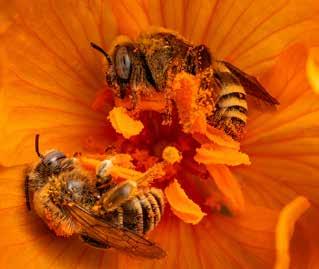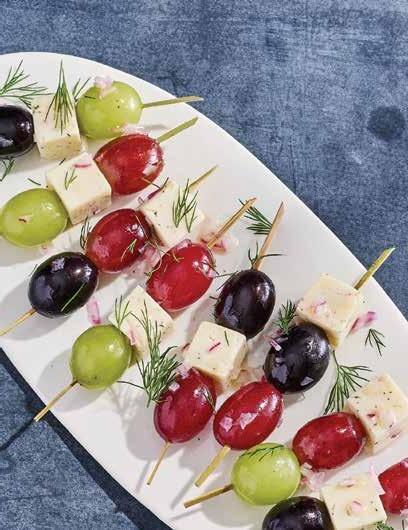






Do it for you and when you get to the end, you will thank yourself every single day.”
St. Luke’s Weight Management Center offers the region’s most comprehensive program for both surgical and non-surgical approaches to weight loss. Our team will help you better manage, care for and overcome obesity and the conditions and illnesses that go with it, including diabetes, high blood pressure, sleep apnea and more. Are you ready for a change in 2025? We are here for you!
Your weight loss journey starts TODAY!
Register for a FREE information seminar below or at sluhn.org/weightloss






Pocono Living Magazine and Pocono Family Magazine, two regional publications filled with articles, features and photography exploring and capturing the real Pocono Mountains living experience.
Our publications can be found at many locations throughout the Pocono Mountains region, and are available by subscription.
PUBLISHING
Pocono Living Magazine© & Pocono Family Magazine©
1929 North 5th Street
Stroudsburg, PA 18360
570-424-1000
pmags@ptd.net www.poconomagazines.com
PUBLISHER/EDITOR
Larry R. Sebring
larry@poconomagazines.com
ACCOUNT REPRESENTATIVES
larry@poconomagazines.com
MAGAZINE & WEB DESIGN
Smart Blonde Creative
Food & Wine Editor
Jamie Marra
PHOTOGRAPHY & ART
John Anzivino
Gayle C. Brooke
Ray Caswell
Pat Coyle
Randall FitzGerald
Ashley Hall
Maurice Harmon
Susan Hartman
Marlana Holsten
Ann H. LeFevre
Barbara Lewis
Marie Liu
Harry Loud
Regina Matarazzo
Janet Mishkin
John L. Moore
Michael Murphy
Justine Nearhood
Roseanna Santaniello
Tom Stone
CONTRIBUTING WRITERS
Kimberly Blaker
Roseanne Bottone
Kathy Dubin-Uhler
Sandra Gordon Tanni Haas
Rebecca Hasting
Amanda Kuhn
Amy Leiser
Marie Liu
Sara Lyons
Jamie Marra
Suzanne McCool
Janet Mishkin
John L. Moore
Allison Mowatt
Jim Werkheiser
Kim Williams
Marty Wilson
ADMINISTRATIVE ASSISTANTS
Kristen Sebring
Linda Spalluto
PROUD MEMBERS OF














• Kiddie Swimming Lessons
• Celebrate Your 4-Legged Friend
• Stress-Free Camping
• Tips for Boating Safely
• Reasons to Love Bees
• Summer Travel with Pets
• A Patriotic 4th of July
• Safe from Warm Weather Hazards
• Helping Kids Stay Healthy
• Improve Dog's Gut Health
• Refreshing Grape Recipes
• Frozen Dog Treats
• Good Money Habits
• Save Money on Summer Vacation
• Worry-Free Haven for Your Pet
55+
• Take on New Hobbies
EVENTS
• In & Around the Poconos

S
By: Kimberly Blaker
o, you're considering signing up your child for their first swimming lessons? Learning to swim not only provides kids the opportunity to enjoy lots of water-filled fun. It's essential to their safety. It also helps kids build strength and endurance, is an excellent form of exercise, and builds kids' confidence. But at what age should they begin taking lessons? Little research has been done on the safety and effectiveness of swimming lessons before the age of four or five. Still, one small study, “Association between swimming lessons and drowning in childhood: a case-control study,” by R.A. Brenner, et al., has been conducted. It found kids between the ages of one and four had an 88% reduced risk of drowning if they had taken swimming lessons.
In light of this information, the American Academy of Pediatrics (AAP) has updated its recommendations. AAP News staff writer, Trisha Korioth, explains in, "Some kids have higher drowning risk: Swim lessons add a layer of protection for all:" “All parents and children over 1 year old should learn to swim, according to the American Academy of Pediatrics (AAP). This is especially important if your child is at a high risk of drowning.”
Korioth explains that children need to learn at least basic swimming skills. These include how to:
• enter the water
• turn around
• come up to the surface
• propel forward a minimum of 25 yards
• climb out of the water
That said, parents must be mindful that while this reduces the risk for drowning, it doesn't make children drown-proof. As many experts have pointed out, swimming lessons often give parents a false sense of security. This actually increases kids' risk of drowning. As it turns out, a substantial percentage of drownings occur in good swimmers and even under parents' supervision. That's because parents often let their guard down when their child knows how to swim.
As for the age to begin swimming lessons, many medical experts recommend against it for babies under the age of one. Infants are more susceptible to skin irritation from pool chemicals, swimmer's ear, and hypothermia when water
"Learning to swim not only provides kids the opportunity to enjoy lots of water-filled fun. It's essential to their safety. It also helps kids build strength and endurance..."

temperatures dip below 85°F. Also, leaky diapers in the pool increase the risk not only to your baby but to all the other swimmers of contracting a parasite. The nasty Cryptosporidium parasite causes nausea, vomiting, diarrhea, dehydration, and weight loss.
As young children grow, they usually come to love bath time. But, as many parents can attest, getting splashed in the face is a whole different ball game. Add to that, a shallow bathtub is far less threatening than a vast, seemingly-bottomless pool. New environments, in general, can also be stressful for children. Some kids are even fearful of water. When kids sense their own parent's fear of the water, or if the child has had a negative experience with water, this can also add to a child's anxiety. Try the following to ease your kid's fears of the water.
1. Provide your child with a variety of water experiences and opportunities to get used to getting their face wet. Let your child wet and wash their own hair. Also, have your child try
the shower with you. In warm weather, give your youngster a kiddie pool to splash around in and a sprinkler to run through.
2. Read storybooks to your child about swimming and swim lessons.
3. Don't force your fearful little one into the pool. It can ultimately increase your child's fears. At the same time, don't make a big todo about your child's fearfulness, either. Instead, offer encouragement and allow your kid time to warm up to the pool.
4. Offer praise for each step of progress your child makes, even if it's just dipping their feet in the water. Look for ways to make being in the water a pleasurable experience.
5. Rewards can help. Offer your child an ice cream cone, trip to the park, or small prize on the way home for taking a big step.
Trained instructors. Claire McCarthy, MD, in “Swimming lessons: 10 things parents should know,” at Harvard Health Publishing, says to look for swim instructors trained and
evaluated under the guidelines of a reputable agency. She includes examples such as the YMCA or Red Cross. Instructor's style. Also, make sure the instructor is childcentered. Teaching kids to swim is different from teaching adults. It requires patience, understanding, and positive reinforcement.
A warm pool. Getting into a cold pool isn't a pleasant experience at any age. It also makes it harder to focus on learning and get comfortable in the water. Make sure the pool is heated to at least 84°F for children over 6. If under 3, the temperature should be at least 87°F.
Safety. Find out the class size and ratio of students to instructors. If you won't be in the pool with your child, ask about lifeguards, especially if it's a larger class. Also, do instructors get in the pool with the kids, or do they instruct from the deck? Here are some excellent guidelines for studentteacher ratios based on the American Red Cross Learn-to-Swim program.
• Children up to 4-years-old and attended in the pool by their parent, 12:1 ratio
• Ages 3-5, with a buoyancy device, 6:1
• Kids 6 and up, 8:1; for advanced classes, 10:1
Chlorine levels. Ask if the pool chlorine and PH levels are tested regularly. Low PH causes eye irritation. Low chlorine levels can be a health risk. If you're in doubt, pick up a test kit at a hardware store.
Open door policy. Make sure parents are allowed some ability to observe if they choose. It can be through a window or at the start or end of classes. When parents can attend the entire class, having additional eyes on the kids adds an extra layer of safety. The problem, though, is it sometimes reduces kids' cooperation. So decide what you're comfortable with and what's best for your child.



"While most dog owners need little reason to celebrate their furry family members, National Dog Month provides a perfect opportunity to show pets a little extra love."
While most dog owners need little reason to celebrate their furry family members, National Dog Month provides a perfect opportunity to show pets a little extra love.
Established in 2004 by the Animal Miracle Network and International Association of Pet Sitters, the month-long celebration promotes responsible pet ownership and honors dogs of all breeds and sizes. Consider these ways you can get involved:
• Adopt a dog from a local shelter or rescue organization
• Organize a dog-friendly event in your community, such as a dog walk or pet parade
• Donate dog food, toys or supplies to a local animal shelter
• Volunteer at a rescue organization or shelter
• Host a dog-themed party or gathering with your friends and their furry companions
• Share photos and stories of your dogs on social media
To take it one step further and help dogs in need in your community, reach out to local pet-focused organizations and see how you can help.
Supporting local shelters by donating money, supplies or your time can aid in the well-being of dogs in your community. Consider organizing a fundraising event or a donation drive to collect essential items for the shelter, such as food, bedding or toys. You can also help spread the word about the importance of adopting dogs from shelters and encourage others to do the same.
Courtesy of Family Features
Lead by example by being a responsible dog owner yourself through showing love, care and respect for your furry companion. Encourage spaying and neutering to prevent shelter overpopulation and educate yourself and others about the responsibilities that come with dog ownership, such as providing proper nutrition, regular veterinary care and training.
There are many ways to help dogs in need, such as volunteering your time at a local animal shelter or rescue organization, assisting adoption events, walking dogs, cleaning kennels or helping with other essential tasks. If you have specific skills or expertise, you may also consider volunteering as a dog trainer, groomer or foster pet parent.
Find more tips for caring for your pet at eLivingtoday.com.


By: Tanni Haas, Ph.D.

"Kids love to go camping, but camping trips can be stressful if you’re not properly prepared for them."
Kids love to go camping, but camping trips can be stressful if you’re not properly prepared for them. Based on my own experiences as well as conversations with other parents, I’ve pulled together a list of some favorite stress-management tips.
If your kids have never been camping, practice at home before you go. Pitching a tent and getting used to sleeping in it can feel strange if you’re not used to it. If you have a backyard, pitch the tent there. If you don’t, lay out sleeping bags in the living room or spend an entire day at a nearby park: that’ll give the kids a good idea of what it’s like to go camping and be in the outdoors.
Packing for everyone can be a challenge. If your kids are old enough, have them pack their things in their own bags. Help them make a list of what to bring, and then let them pack themselves. Also make sure the bags are easy to carry or pull in case you decide to leave the car behind to go hiking.
When kids are bored, they often act up, and you get stressed. To avoid that from happening, involve them in all aspects of the trip, from choosing the best camp site, to deciding what to do, to buying the equipment that you need. In fact, don’t just have the kids help you buy equipment like tents and fishing rods: have them shop with you for cooking supplies and food.
When you review the campsite options with the kids, talk to them about what they’d like to do there. Choosing a campsite with activities that no one is interested in can backfire. Would your kids like to rough it, or do they prefer a site with lots of amenities? What activities would they prefer - berry picking, hiking, boating, fishing, or swimming?
Wherever you choose to go camping, you’ll need some specialized gear – a tent, sleeping bags, a cooking device, and kitchen supplies. Buy quality stuff, make sure you know how to operate the equipment, and store everything neatly in boxes and containers.
One key to a stress-free camping trip is to leave plenty of time for unstructured play. You never know what will end being exciting to the kids. They may make a new friend as soon as you arrive and can think of nothing better than to spend the whole time with them. Remember: you’re not there to accomplish anything other than to have a good time.
The kids may want to explore the camp site and surrounding areas with their new friend, but safety should always come first. Set ground rules for how far they can venture off and have agreed-upon emergency procedures for what to do if they get lost. If there’s no mobile phone service, give the kids a whistle and tell them to only blow it if they’re lost.
While everyone hopes for great weather, there’s no guarantee what Mother Nature will bring. So, bring raincoats, warm sweaters and socks, and waterproof hiking boots. Even if the weather holds during the day, the temperature at night can drop dramatically.
If you find yourself stuck in the tent all day due to rain or the kids are bored with what the camp site has to offer, have alternative entertainment options. Bring electronic games, including some that don’t require internet access, board games, and playing card for everyone to enjoy.
You’re going to be stressed out if you try to do everything on your own. Have the kids help you. Get them to pitch the tent and roll out the sleeping bags. Have them gather firewood, build a fire, help cook the meal, and clean up afterwards. The more you share experiences with each other, the more memorable the trip will be.

Tanni Haas, Ph.D. is a Professor in the Department of Communication Arts, Sciences, and Disorders at the City University of New York – Brooklyn College.

Your photos could be seen by more than 26,000 readers when you enter them in Pocono Living Magazine’s Annual Photo Contest. The contest is open to amateur photographers only. (Those who do not earn a majority, over half, of their income as photographers).
You may enter no more than 15 images, so choose your best shots.
Categories are “Scenics”, “Wildlife”, “Florals”, and “Historical Structures”.
Only photographs that are representative of the Pocono Mountains should be submitted. Individual photos should be attached to an email message and sent to: larry@poconomagazines.com. Photos submitted must be high resolution, (300 dpi), jpg or tiff files or they cannot be used. You must include your full name in the title with each photo submitted as you would like it to appear in the magazines. We will contact you for your mailing address to receive your prize if your photo is chosen as a winner in the contest.
Winning photos, along with the names, and hometowns if available, of each winner will appear in the October/November 2025 issue of PoconoLivingMagazine and the PoconoMagazines.com website. Some lucky participants may have their photo featured as a cover on PoconoLivingMagazine!
Scenics | Wildlife | Florals | Historical Structures
Your photos could be seen by more than 26,000 readers when you enter them in Pocono Living Magazine’s Annual Photo Contest.
1. Contest open to amateur photographers only.
2. Contest opens April 1, 2025 and closes August 1, 2025.
3. Enter electronic files by email to: larry@poconomagazines.com.
One photo at a time.
4. Submitted photos must be as an attachment to an email message, (not within the body of the email), and be high resolution (300 dpi), jpeg or tiff files.
5. Please include your contact information (phone number, mailing address & email address) with the submission.
6. Each contestant may submit no more than 15 photographs. Choose any combination of categories.
7. Photos submitted may be judged for inclusion in this year’s contest, and in all future year’s contests, so you have several chances to be a winner.
8. Entered photos must have been taken recently, from January 2015 to present and be of a scene or subject found in the Pocono Mountains only.
9. Categories are: Scenics (landscapes, rivers, lakes, waterfalls, etc.), Wildlife, Florals, and Historical Structures.
10. Judging will take place in August and September 2025.
11. Winners will appear in the October/November issue of Pocono Living Magazine.
12. Contestants will retain all rights to their photography, but agree that Pocono Magazines, LLC and Pocono Mts. Publications, LLC may use their photos from time to time in the magazines that they publish and on the Pocono Magazines.com website provided proper credit is given to each photographer.
Questions? Email the editor at: larry@poconomagazines.com

Make the most of summer: Tips for boating confidently and safely




Looking for ways to make the most of your time outdoors this summer? Grab your crew and go boating! Being on the water is one of the best ways to disconnect from distractions on land, allowing you to relax and recharge in nature. Not only is there a scientific connection between boating and happiness - the sight and sound of water promotes wellness by increasing serotonin, lowering cortisol and reducing stress - but boating is also a fun way to spend time with loved ones and meet new people within the boating community. There are plenty of ways to get on the water whether you rent, charter, share, join a boat club or own a boat.
Remember, boating should be enjoyable, not intimidating. Before stepping on board or taking the helm, brush up on your nautical know-how to boost your confidence and create a safer environment, allowing for a pleasant, stress-free day on the water for everyone involved.
"There's nothing like spending a day on the water - where freedom meets fresh air, stress melts away and lasting memories are made with your favorite people," said Ellen Bradley, senior vice president of Discover Boating. "Whether you're new to boating, a seasoned captain or a passenger along for the ride, it's always smart to brush up on the rules of the water. Discover Boating makes it easy with expert tips and safety resources right at your fingertips."
Discover Boating is a one-stop destination for all things boating, from safety and education articles, maintenance checklists and boating destinations, to finding your dream boat, locating verified dealerships in your area and more.
Below are five tips from Discover Boating to improve your boating knowledge to ensure the best possible experience on your next boating adventure.
Learn boating safety essentials. View Discover Boating's new video series in collaboration with Progressive Insurance® for expert tips ranging from preparing your boat for the season to trailering, boating with kids and furry friends and more. If you plan on buying a boat or you are a new boat owner, consider getting boat insurance for an added layer of security and protection.
Take a boating course. Sign up for a boating lesson to hone your powerboating, sailing or watersports skills by mastering the basics while having fun along the way. On-water training courses, watersports camps, youth boating programs and more are offered across the country.
"There's nothing like spending a day on the water - where freedom meets fresh air, stress melts away and lasting memories are made with your favorite people."
Visit a boat show. Boat shows are an ideal place to immerse yourself in the boating lifestyle and provide a unique opportunity to meet face-to-face with - and shop - a variety of boat dealers and marine product companies all under one roof. Most boat shows also offer hands-on demonstrations and educational opportunities for boaters of all experience levels. Find a boat show in your area.
Look for the seal of approval. When shopping for a boat, whether at a boat show, online or at a dealership, check to make sure it is NMMA Certified. NMMA Certified boat and trailer manufacturers have been independently inspected to ensure they meet strict industry standards for safety and construction, as well as all federal regulations. Look for the NMMA Certified sticker near the helm of a boat.
Maintenance matters. Similar to cars, there are a few areas that require regular maintenance by the owner, and a few areas that require maintenance at routine intervals, which most leave to the professionals. Prepare a boat maintenance checklist that covers everything from engine needs to cleaning to electrical systems to ensure your boat has a long lifespan.
Visit DiscoverBoating.com for safety tips, boat shopping tools, easy ways to get on the water and more. Be sure to tag @ DiscoverBoating and use #SeeYouOutHere on social media to share your next boating adventure.
Courtesy of BPT









Take the opportunity to celebrate not only the beloved honey bee, but North America’s 4,000 species of native bees, many of which are busy right now.
“Throughout spring and summer, these insects dutifully pollinate crops and wildflowers, playing a vital role in fostering healthy ecosystems,” says Clay Bolt, manager of Pollinator Conservation and Great Plains communications, World Wildlife Fund.
According to Bolt, native bee species are beautifully varied in their appearance, behaviors, feeding habits and habitats.
They can be striped, metallic, fuzzy, thin and rotund, in a spectrum of colors. The world’s smallest species—the Euphorb
mini-fairy bee—is only found in southern deserts. At 2 millimeters, it is about as long as a U.S. nickel is thick. Different bee species fly at different times—early morning, daytime or night. Many emerge seasonally in spring or summer, while others remain hidden underground for years awaiting summer monsoons. Bees inhabit diverse environments, from cold mountain peaks to beaches. Generalist species visit many flower types, while specialists pollinate only specific flowers. And unlike bumble bees and other hive-dwelling bee species, such as honey bees and stingless bees, over 70% of the world’s bee species are in fact solitary, hardworking moms who quietly nest in overlooked places like decomposing logs and alongside garden paths.
If you’ve ever asked yourself, “what is a bee?” you might be surprised to learn that they are vegetarian wasps. However,
unlike their wasp relatives, which often feed their young protein in the form of paralyzed insects and the hamburger they might steal from your picnic table, most bees provide their offspring with protein made from pollen mixed with nectar. The mother bee compacts these materials into a pellet and places it within her nest cavity, lays a single egg atop the mixture, then seals the chamber where the young bee will develop entirely without maternal assistance.
Sadly, bees face threats to their survival, but there are steps you can take to help protect them.
Bees need healthy, pesticide-free foods throughout their lives. This is one of the greatest gifts you can offer these pollinators, especially because parks and gardens often grow flowers that only bloom during peak summer. By planting a variety of plants that flower from early spring through autumn, the number of native bees and other pollinators visiting your garden will increase exponentially.
“Through small acts of kindness, you can transform the lives of these remarkable creatures, while filling your heart with profound hope and wonder as you witness their delicate yet ongoing care of our shared world,” says Bolt.

“Through small acts of kindness, you can transform the lives of these remarkable creatures, while filling your heart with profound hope and wonder.”
World Bee Day also kicks off World Wildlife Fund’s new “Stories of Hope and Wonder,” an ongoing series that connects people to the wonder of nature and offers hope for a future benefiting both people and wildlife. Each month, “Stories of Hope and Wonder” will feature a different species overcoming some of nature’s toughest obstacles to ensure its survival. To access these stories, visit www.worldwildlife.org/ hopeandwonder.
Bees are industrious creatures that are essential to vital food systems and healthy ecosystems. While bees are at risk, individuals can make all the difference in their own backyards this World Bee Day and beyond.



















For pet owners, cats and dogs are part of the family, which means when it’s time to head out of town this summer, the four-legged friends get to come along, too.
In fact, a survey conducted by Motel 6 revealed that of 2,000 Americans with summer leisure plans, the vast majority of those traveling with pets this summer (90%) are bringing their dog, and more than a quarter (31%) are bringing their cat.
While traveling with pets can be a handful, Motel 6 and its Chief Pet Officer, Garfield, fresh off his wild adventure in “The Garfield Movie,” offer these tips to help make the journey easier, safer and more fun.
Pack the Essentials: Travel anxiety is real for your fourlegged friends, too, so keep the experience as “pawsitive” as possible by packing your pet’s favorite toys and snacks. Don’t forget to pack enough food, like lasagna; water; collapsible food and water bowls; and a favorite blanket or bed to provide a sense of familiarity.
Map Out Stops: One in 6 (16%) Americans with summer travel plans are driving to their destinations because they plan to bring their pets along. Travelers should map out breaks, especially when it comes to stopping for meals, in anticipation of traffic and construction. This can help ensure they find spots for bathroom breaks and a chance for active pets to exercise. Even lazier pets can enjoy the fresh air.
Find Pet-Friendly Lodging: As you plan your getaway, look for pet-friendly lodging options with plenty of places to lounge, like Motel 6, which offers travelers and their four-legged friends affordable accommodation, and pets always stay free. This helps take the stress out of researching hotel pet policies and paying additional fees. Traveling pet parents can join the free My6 discount program to receive a minimum of 6% off every stay at locations across the country and access to hundreds of pet and travel benefits.


Travel Safely: If you’re planning to travel with your pets, ensure they receive the royal treatment by researching how to safely transport them during the trip. The Humane Society of the United States recommends that cats and dogs travel in their crates or carriers anchored by a seatbelt to prevent them from moving around the car. It’s important to never leave your pet alone in the car or place your pet in the front seat because it could lead to injury. Always keep pets on leashes when outside, no matter how well-trained they are, as new surroundings or unexpected noises can startle them.
Remember to Have Fun: Travelers’ top reasons for bringing their four-legged friends on trips include spending quality time with them and the joy of seeing their pets happy (39%), making new memories with their pets (34%), seeing their pets’ reactions to new experiences (32%) and the extra level of companionship pets bring to trips (29%). A few ways to reserve quality time with your pets include dining at pet-friendly restaurants (preferably ones with unlimited cheese), locating nearby green spaces or parks to play, trying new experiences together or going on walks. For those who like a more leisurely travel experience, don’t forget to add a quick cat nap with your pet to your schedule.
As you look to map out your summer travel plans, visit Motel6.com to find pet-friendly, affordable lodging.

By Rebecca Hastings

Thinking of the 4th of July always brings images of parades and fireworks. These are great ways to celebrate, but there is a lot you can do to have fun with your kids and feel patriotic this holiday. Try these ten ideas for fun ways to celebrate the fourth with your family.
Many families don’t even know why we celebrate the fourth. Sometimes there are even mixed feelings about the holiday considering difficult parts of the nation’s history or the current state. You can honor all of those feelings while still recognizing why we celebrate.
The Fourth of July celebrates America becoming a nation. The Declaration of Independence was adopted on July 4, 1776. Today, we celebrate to honor the founding of the United States and the freedom it represents.
A fun way to share this with kids is with books. Some great options are:
• The Story of America’s Birthday by Patricia A. Pingry
• The 4th of July Story by Alice Dalgliesh
• Blue Sky White Stars by Sarvinder Naberhaus
• Founding Mothers: Remembering the Ladies by Cokie Roberts
Hanging an American flag is a great way to get in the red, white, and blue spirit. If you don’t have a full-size flag, your kids can paint or color one to hang in the window. You can even use sidewalk chalk to make one in the driveway. Kids also love the small flags available at this time of year. Try lining your walkway with them or putting one by your mailbox.
You just need red and blue dye to make a patriotic tie-dye. White cotton shirts or tank tops are perfect for a fun Fourth of July craft to make before the fourth. Have the whole family make them and then wear them to your Fourth of July activities.
"No matter how you decide to celebrate, remember that it is a privilege to be able to do so."
Try fun face paint and nail polish for a festive look to go with your shirts. Red, white, and blue strips and stars are a great way to show your American spirit.
Grab some grass-friendly spray paint and make your yard the talk of the neighborhood. Spray some red and white stripes for the perfect way to stand out. You can even make star-shaped cut-outs from cardboard as a stencil for the white stars and blue background.
.
A family trip to a Historic National Landmark is a great way to feel patriotic for the Fourth of July. You can make it a day trip or a longer getaway to visit a noteworthy place or monument in United States history. Search for National Landmarks in each state online and set out on an educational adventure.
Have some family craft time in honor of the red, white, and blue. You can try a simple craft like painting rocks with stars
and stripes to leave around the yard or town. This is great for all ages and doesn’t require a lot of supplies. A quick online search for Fourth of July crafts will give you plenty of crafty ideas!
Create or download a holiday-themed scavenger hunt. The list can challenge people to find things like a flag, a holiday shirt, a soldier, or an apple pie. You can customize the list for your needs. This is great to do during a parade or family cookout.
The freedom we have in the United States is maintained by dedicated service men and women. Consider visiting a VA hospital, making cards or care packages for veterans, and thanking servicemembers in the community.
You can eat so many things to represent and celebrate the Fourth of July. Try some of the holiday classics like watermelon and apple pie. You can also make themed treats like a red-whiteand-blue trifle or star-shaped cookies.
No matter how you decide to celebrate, remember that it is a privilege to be able to do so. While there is still important change and progress to be made, we can celebrate our country’s founding in fun ways.

Rebecca is a former teacher and mom of three who is passionate about authenticity, faith, and family. Her books are available on Amazon and she has been featured on sites such as The Washington Post and Parents. In real life, she can often be found typing words, driving her kids places, or wherever there is chocolate.

Enjoying the great outdoors is a common pastime for many when temperatures warm, and that includes those with furry companions. However, warmer weather also comes with a variety of hazards to those four-legged friends.
To help keep your pets safe and enjoy all the season has to offer, consider these tips from the experts at VCA Animal Hospitals, which has more than 1,000 locations across North America and cared for more than 4 million pets last year.
Leaving pets in the yard for extended periods without access to shade or water on hot days, vigorous exercise or leaving them in vehicles even with windows rolled down can lead to heat stroke, a term commonly used for hyperthermia, or elevated body temperature. Pets suffering from heat stroke (temperature higher than 106 F) can have elevated breathing rates, dry or sticky
gums, abnormal gum color, bruising in the gums, may appear lethargic or disoriented and can have seizures. Safe, controlled reduction of body temperature is an immediate priority. Cool water may be poured over the head, stomach, armpits and feet, or cool cloths may be applied to these areas and continually replaced.
Allergies are common in both dogs and cats, and warmer weather brings out fleas and ticks that can cause allergic reactions. Bites may cause intense itching, leading pets to scratch or chew on themselves, potentially causing hair loss. An effective, year-round flea and tick preventative regimen is key to keeping dogs and cats pest free and limiting allergic reactions. In cases of severe itching, antihistamines or corticosteroids (steroids) may be prescribed to provide immediate relief.
Cookouts may mean barbecue chicken, ribs, steak, corn on the cob and fresh fruit like watermelon. Be wary of bones, which are not digestible and can pose a choking hazard, cause intestinal blockage or break into shards and cause irritations or infections. Similarly, corn cobs are not digestible and can get stuck in the stomach or intestinal tract, causing an obstruction. Watermelon rind and seeds can also block the GI tract, so be sure to remove the rind and seeds.

"Allergies are common in both dogs and cats, and warmer weather brings out fleas and ticks that can cause allergic reactions."
Warm weather means festivals and parties. However, these outdoor gatherings often include items that are dangerous to pets:
Glow sticks contain an oily liquid called dibutyl phthalate (DBP). While non-toxic in small amounts, DBP can cause gagging, drooling and irritation of the eyes, mouth and skin if pets bite glow sticks. If your pet chews a glow stick, offer water or a treat to tame the bitter taste. Turn off the lights and wash any glowing areas.
Citronella candles work well as a deterrent for flying insects but open flames can burn whiskers and noses. The fumes may also cause breathing issues when inhaled and consuming the wax can cause GI and nervous system issues.
Popped or non-inflated balloons can pose choking risks. String for anchoring them can also cause intestinal issues if swallowed and pets could become entangled in the string, posing tripping and strangulation risks.
While cats naturally shy away from water, both dogs and cats can fall into swimming pools accidentally. Dogs can sometimes struggle with getting out of the water even if they’re capable swimmers, so be sure to teach them to navigate the swim-out area and keep an eye on pets in the water – even good swimmers can tire of treading water and drown.
Find more tips to safely enjoy the warmer months with your furry friends at VCAHospitals.com.
Courtesy of Family Features








"Consider what you can do to help your kids stay physically and mentally healthy. One option is to let yourself be inspired by some of the many wellness podcasts available."

By: Tanni Haas, Ph.D.
July 24 is International Self Care Day, a great occasion to consider what you can do to help your kids stay physically and mentally healthy. One option is to let yourself be inspired by some of the many wellness podcasts available. The thing about podcasts is that you can listen to them whenever you have a spare moment, including when you’re doing other things. Here are some of the best ones.
(Available at: Apple, Listen Notes, Podchaser)
Created and hosted by Dr. Cindy Gellner, a well-known pediatrician and mom of two sons, Healthy Kids Zone is a longrunning podcast which explores all aspects of kids’ health, from infancy through the teen years. On this podcast, you’ll find great advice on anything from treating your kids’ bug bites to dealing with sleep issues and managing their social media use. It’s a great one-stop resource for health and wellness information.
(Available at: Apple, Listen Notes, Spotify)
Like Healthy Kids Zone, The Kids Health Network is also produced by a physician: Dr. Andrew Leech, the father of two daughters. This podcast is also aimed at parents of kids of all ages and much of the content focuses on kids’ emotional health. Through conversations with other experts, Dr. Leech explore important topics such how to best parent neurodiverse kids, how to help kids cope with grief and loss, and what to do when your kids are being cyberbullied.
(Available at: Apple, Listen Notes, Spotify)
Natural Super Kids offers a different approach to kids’ health. The brainchild of Jessica Donovan, a naturopath and author of many books on alternative medicine, this podcast focuses on how parents can use natural remedies to help their kids stay healthy and strong. Recent episodes discuss how parents can manage allergies, asthma, ear infections, sleep issues, stomach pain and many other ailments in a holistic way.
(Available at: Apple, Listen Notes, Spotify)
Peace Out also promotes a holistic approach to kids’ health but in a very different way than Natural Super Kids. Instead of offering straightforward advice, it includes stories, breathing and visualization exercises and meditation techniques to help kids to better center themselves and become less anxious and stressed. It’s produced by Chanel Tsang, a well-known Montessori educator who’s also a certified meditation, mindfulness, and yoga teacher.
(Available at: Apple, Audible, Spotify)
Unlike the prior podcasts, The Youth Fitness Podcast is almost exclusively focused on how parents can help their kids stay physically fit. Created and hosted by Jeff and Mikki Martin, the developers of a widely-used strength-and-conditioning program for kids called the “Brand X Method,” this podcast explores issues such as how parents can encourage their kids to become more physically active and how to help them develop their stamina and resilience.




When it comes to humans, gut health can be a great indicator of overall health. Often, when illnesses or conditions arise, symptoms are present in the gastrointestinal system. It makes sense that when you’re feeling bad or extra stressed, you can feel it in your stomach or your bowels – and the same is true for your pet.
“When my dogs are dealing with stomach issues, they’re not themselves – they just seem off,” said Kaley Cuoco, co-founder of Oh Norman!, a pet wellness brand. “That’s why I became so obsessed with finding a way to boost their digestive health.”
Gut health involves several components of the gastrointestinal tract, including the microbiome (bacteria, viruses and fungi) and digestive system, which controls how the body breaks down and absorbs the nutritional components of food.
A healthy gut allows your pet to live comfortably with good overall wellness and a properly functioning immune system.
Dogs with healthy guts have a moderate, consistent appetite and maintain a healthy weight. They have adequate energy and even look visibly healthy with a shiny coat. Their stools are firm and regular.
Conversely, dogs with gut health problems may be lethargic and have problems with excess or too little weight. They may experience pain, bad breath, poor skin condition and a variety of gastro symptoms like constipation, gas, vomiting or diarrhea.
If you’re concerned about your dog’s gut health, consider these tips from the animal-loving experts at Oh Norman!:
Consult with your veterinarian. Problems with gut health can have a dizzying number of sources, so if your dog exhibits signs of a gut health issue that seem severe or don’t go away within a day or two, it’s a good idea to talk with an expert. The advice you get will be tailored to your pet’s specific circumstances and needs so you can help your four-legged friend feel better fast.
Pay attention to your dog’s diet. A good gut-health eating plan is fiber-rich and balanced with protein, vegetables and healthy fats. Foods that contain probiotics support good bacteria while prebiotics help feed good bacteria. Food allergies or intolerances can also trigger gut health problems, so pay attention to ingredients that may be problematic for your pet.
Add supplements to boost the microbiome. If you’re concerned, and your veterinarian agrees, it may be useful to supplement your dog’s diet to support gut health. One option is Good Effing Gut, a functional soft chew from Oh Norman! formulated to support digestive and immune health in dogs. Suitable for dogs of all ages, these chews promote a balanced gut microbiome, support healthy digestion and immune functions and may aid weight management. Available in a natural pumpkin cinnamon flavor, the chews offer safe, effective ingredients including pumpkin and chicory root (prebiotics), Bacillus subtilis (probiotic) and Lactobacillus acidophilus (postbiotic), which work together to promote nutrient absorption, maintain healthy digestion, support skin and coat health and contribute to overall canine wellness.
Eliminate external factors. If your dog’s gut health issues aren’t driven by diet, some environmental adjustments can make a difference. For example, creating a more peaceful, secure living environment can help settle gut problems.
Practice good general care. Providing your pet with consistent loving care can also play a role in gut health. Dogs that feel safe, are well-disciplined, get regular exercise and remain well-hydrated tend to have stronger gut health.
Learn more about gut health for your dog at ohnorman.com.
Courtesy of Family Features















































Gearing up for outdoor entertaining this summer calls for seasonal decor, plenty of seating, yard games and more, but just about everyone’s favorite element is the main attraction: the food.
Make fresh, delicious Grapes from California the star of your summer show to elevate celebrations and get-togethers ranging from your nearest and dearest to entire crowds. Grapes are perfect for incorporating into warm-weather recipes as a flavorful addition to main courses, sides and desserts. Or you can simply serve them as an easy, compatible snack that complements an array of your favorite summer dishes.
For a plant-forward option that’s anything but ordinary, vegetarians and burger lovers alike can enjoy Southwest Black Bean-Lentil Burgers with Charred Grape Salsa. Hearty black bean patties are perfectly complemented by the smoky-sweet flavor of homemade charred grape salsa. Plus, added spice from cumin and chili powder mixed with fresh avocado and cilantro make a satisfying mix of Southwest flavors.
Keep guests’ appetites at bay with fresh, tangy, visually stunning Dill Pickle Marinated Grapes and Cheese that let the natural sweetness of grapes shine through. Each bite pairs that familiar sweet flavor of grapes with the creaminess of Havarti and savory pickles to create a vibrant yet easy appetizer.
A welcome addition to the menu on those hot summer days, Frozen-Yogurt Grape and Coconut Bites are fun, simple to make and refreshing. Each bite features a sweet California grape dipped in creamy Greek yogurt and rolled in shredded coconut so you’ll feel like you’re on a tropical retreat. All it takes is three ingredients for a cool healthy snack you can share with loved ones.
Discover more summertime recipe solutions by visiting GrapesFromCalifornia.com.
Servings: 8
Grape Salsa:
4 cups red or black Grapes from California
3/4 medium white onion, peeled & cut into 1/4-inch-thick slices
1 medium jalapeno pepper, halved, stemmed and seeded
1/3 cup lightly packed cilantro leaves
1 1/2 tablespoons lime juice
1 clove garlic, minced
Burgers:
2/3 cup cooked black or green lentils
2/3 cup cooked brown rice
1/2 cup walnut pieces
1/2 cup chopped onion
1/3 cup dry breadcrumbs
3 tablespoons lime juice
1 tablespoon chili powder
1/2 teaspoon ground cumin
2 cans (15oz each) black beans, rinsed, drained & patted dry
2 eggs
olive oil cooking spray
8 wheat burger buns, toasted
lettuce leaves (optional)
2 ripe avocados, peeled, pitted and sliced
To prepare salsa: In grill basket over medium-high heat, grill grapes, onion and jalapeno pepper 10 minutes until lightly charred, stirring occasionally. Let cool then place in food processor with cilantro, lime juice and garlic. Process until finely chopped.
To prepare burgers: In food processor, pulse lentils, rice, walnuts, onion, breadcrumbs, lime juice, chili powder, cumin, beans and eggs until coarsely chopped with some small pieces still visible, scraping down sides and moving mixture from bottom of bowl to top to blend evenly.
Using wet or lightly oiled hands, shape into eight patties. If mixture is too soft, freeze briefly to firm. Coat on both sides with olive oil spray and, in two skillets over medium heat, cook 10 minutes, turning occasionally and coating with additional olive oil spray. Burgers should be browned and cooked through.
Place lettuce on bun bottoms and top with burgers, avocado slices, grape salsa and top buns.
Celebrate the holidays surrounded by great company and even better cuisine in the Pocono Mountains. From romantic dinners by candlelight to farm-to-table experiences, our local chefs are serving up something for every palate. Visit PoconoMountains.com to see all of our mouth-watering dining options and make your reservation.


Servings: 8
3 cups whole Grapes from California
1 1/4 cups dill pickle juice
3 tablespoons minced red onion
1 1/2 tablespoons extra-virgin olive oil
1 package (6-8 ounces) dill Havarti cheese, cut into bite-size cubes
1 pinch crushed red pepper
toothpicks or small skewers
fresh dill leaves, for garnish (optional)
In medium bowl, combine grapes, pickle juice, onion, olive oil, Havarti cheese and red pepper. Stir well then cover and refrigerate overnight, or up to 24 hours, to marinate, stirring occasionally.
Remove from refrigerator and let sit at room temperature 1 hour, or until olive oil has softened. Stir again then thread grapes and cheese onto decorative toothpicks or small skewers. Garnish with fresh dill leaves, if desired, and serve.

Servings: 10
Bamboo skewer
60 medium Grapes from California
1 individual cup (5.3 ounces) vanilla or lemon Greek yogurt
3/4 cup unsweetened coconut flakes
Using bamboo skewer, pierce one grape on tip and swirl stem end into yogurt, covering about 3/4 of grape to show color. Sprinkle with coconut, turning skewer to coat all sides.
Place on waxed or parchment-lined tray and remove skewer. Repeat with remaining grapes, yogurt and coconut. Freeze several hours, or overnight. Transfer to tightly covered container and store in freezer.





After a long day at work or an eventful weekend, don’t just treat yourself to a delicious dessert – make sure you’re treating your pets, too. These homemade dog treats are easy to make with organic ingredients so you can show your pets some love while feeling confident that you aren’t putting their health in jeopardy.
Gather just a few ingredients and cute dog-shaped ice molds (like paws or bones) to give Fido the attention he deserves. The best part: these treats keep well in the freezer, meaning you can make a bigger batch to stay stocked up on your furry friends’ new favorite treat.
Find more ways to take care of your pets at Culinary.net or eLivingtoday.com.
1/2 cup plain Greek yogurt
2 tablespoons organic peanut butter (no salt added, no xylitol)
1 medium ripe banana
In blender, blend Greek yogurt, peanut butter and banana until smooth.
Place silicone molds on baking tray to prevent spills. Fill molds with blended mixture and freeze 3 hours, or until firm. Store in freezer-safe container or zip-top bags.
10 fresh strawberries
1/2 cup plain Greek yogurt
2 tablespoons raw honey
Remove stems from strawberries and slice in half. In blender, blend strawberries, Greek yogurt and honey until smooth.
Place silicone molds on baking tray to prevent spills. Fill molds with blended mixture and freeze 3 hours, or until firm. Store in freezer-safe container or zip-top bags.
Courtesy of Family Features & Culinary.net











Can your dog help you save? New Empower research shows that Americans associate pet ownership with positive money habits, with 39% of people saying it inspires them to be more financially responsible, and 36% saying it motivates them to reach their financial goals.
• More than a third of Americans (35%) say their pets motivate them to work harder and seek higher pay.
• Over half of Americans (57%) include their pets' needs in long-term financial planning.
• 31% of Gen Zers (28% overall) would take a pay cut for a job with flexible hours so they could spend more time with their pet; 34% of Millennials (30% overall) would turn down a higher paying job to spend more time with their animal companions.
• 41% say they'd be more likely to return to the office if they could bring their pet to work; 26% say their dream job would offer pawternity leave (time off for getting a new pet).
• 1 in 5 Gen Zers have a dedicated savings account for their pet's needs.
The majority of pet owners (94%) consider their four-legged friends part of the family, and more than half (57%) include their pets' needs in long-term financial planning. Nearly 2 in 5 (39%) report becoming more financially responsible due to owning a pet. Close to a third (31%) saved up for pet expenses before getting one.
About 7 in 10 pet owners want to spoil their animal companions (71%), while almost a third buy things for their pets when they feel guilty about not spending enough time with them (32%). Income may also play a role in pet spending: 42% say the more money they make, the more they splurge on their pets.
What would you do if your pet suddenly needed a trip to the vet? Over three-quarters of Americans (77%) would tap into
their savings or emergency fund to pay for an unexpected medical expense. Enrolling in pet insurance is one way to be prepared.
Americans spent an average of $1,355 on their pets in the past year, and nearly 1 in 5 (19%) plan to spend more in 2024. On average, they spend $1,200 on food and $828 on vet bills each year. As for birthday and holiday pet gifts, Americans say they spend an average of $24 on those occasions.
Dog owners spend an average of 14% more on their pets than cat owners. But what about spending on pets versus people?
One in 3 (33%) pet owners say they buy more things for their pets than themselves, and over 2 in 5 (42%) spent more on their pets than on their closest friends. Some (16%) spent more on their pets than their significant other.
More than a third of Americans (35%) say their pets motivate them to work harder and seek higher pay. For some, time is money: 34% of Millennials would decline a higher-paying job if it meant more time away from their pets (30% overall). Another 31% of Gen Zers (28% overall) would consider a pay cut in exchange for a job that offers flexible hours so they can spend more time with their pets.
People's love for their pets often extends into their workplace preferences, with 41% of pet owners being more likely to return to the office if allowed to bring their pets.
Access the full report on The Currency™Methodology: This study is based on online responses from 1,000 pet owners in American commissioned by Empower from April 11-12, 2024.
"More than a third of Americans say their pets motivate them to work harder and seek higher pay."
Courtesy of BPT

By: Tanni Haas, Ph.D.
Taking the family on a summer vacation can easily end up being quite expensive. Thankfully, there are things you can do to save money on your trip. Based on my own experiences as well as conversations with other parents, I’ve pulled together a list of some great money-saving tips.
My partner and I each put $5 in an empty coffee tin every evening all year round. By summertime, we’ve saved up more than $3500. That helps cover our vacation expenses. If $5 a day is above your budget, putting aside some amount on a daily basis can quickly add up to a nice chunk of change.
Create a detailed budget for what you’re able and willing to spend on your vacation - and then stick to it. Overspending often occurs because people don’t have a budget and, instead, just pay for things without considering how much they’re actually spending in total. Divide your budget into transportation, accommodations, and food, and factor in money for things that’ll make the vacation extra memorable for your kids, like amusement entrance fees. You want to have fun but not go broke!
When you pick your destination, decide - as a family - where you’d like to go. It’s hard to have a great vacation if there’s nothing about the destination that excites any of you. Also
take into account the local cost of living, if you’re going to a foreign country. The foreign exchange rate is a good indicator. Exchange rates can fluctuate widely, so be sure to get the latest information. The more foreign currency you get for each dollar, the less expensive your vacation will be.
You can save lots of money by doing a house swap or by renting a home (think Airbnb). However, if you prefer a hotel, you can save money by staying at a distance from the city center, and making sure the place has a kitchenette or offers a complimentary breakfast. Staying outside the city center, and then driving in to see the local sites isn’t only cheaper: it’ll give you a chance to see where local residents live.
If you plan to swap or rent a place, invite family or friends to join you. The per-person expense for accommodation will go down dramatically. If your kids bring some of their best friends from home with them, they’ll have someone to hang out with. Everything is much more fun when they can do it with a good friend.
Save money by creating a detailed itinerary of what you plan to do when you arrive, and then make reservations online before you go. Most tourist sites offer deep discounts if you
"Divide your budget into transportation, accommodations, and food, and factor in money for things that’ll make the vacation extra memorable"
• 60 acre lake with 300 campsites
• Paved roads
• Electric, water and cable TV hook-ups; 100 campsites have sewer hook-ups
• 8 heated bathouses, store, laundry and propane
• Boating, boat rentals and fishing (no fishing license required)
• Indoor pool with 2 Jacuzzis and Sauna
• Outdoor Pool
• Swimming Beach
• Lighted tennis, racquetball and basketball courts
• Softball field
• Game room, planned activities
• Open all year
• Woodall 5W rated
P.O. Box 850 • Marshalls Creek, PA 18301 570-223-0123
Reservations only: 800-345-1369 www.otterlake.com






reserve your tickets online and in advance. Also look for family passes for extra discounts and tourist passes that cover multiple attractions. By reserving everything online before you go, you also avoid standing in long lines which leaves everyone tired and frustrated.
Some of the most fun things you can do on any vacation won’t cost you anything. Most vacation spots have special celebrations during the summer, like concerts, fairs and parades. The best way to find about all the free activities at your destination is to go online or to pick up brochures at the local visitors bureau.
When it comes to food, plan your meals in advance and limit the number of times you eat out. One option is to eat breakfasts in, pack your lunches to go, and only eat out for dinner. Another way to reduce expenses is to look for restaurants where kids eat free or at a discount. Many restaurants let kids age 12 or younger eat for free; other

restaurants offer a kids’ menu with smaller portions at lower prices.
Pay for as much as you can with a debit card or cash. Avoid credit cards: the interest rates are sky-high. Only use credit cards if you’re absolutely sure you can pay them off as soon as you return, if they offer discounts on local attractions, if they don’t charge any foreign transaction fees, or if you can collect lots of points for your next vacation by using them.
Many people spend a ton of money on souvenirs. They’re exciting when you first get them, but the kids quickly lose interest in them and they ultimately end up unused or in the garbage. As an alternative, encourage the kids buy one postcard from each destination, which they can use to write down their favorite memories, and then mail home. It’ll make for a great collection that they can keep in an album and look back on to reminisce about their vacation.



It’s not just a day of shopping here in the Pocono Mountains—it’s an experience. Wander our historic streets. Explore our art galleries. Find unique local goods. And stop for a bite at one of our top-rated neighborhood restaurants along the way. Discover all of our shopping and sights now at PoconoMountains.com.

Enjoying the warm weather and your home’s outdoor living areas is one of the best parts of the year, especially when these areas are well-maintained. Now that warm weather is here, check out these hassle-free ways to refresh your patio, deck, and garden for maximum fun and relaxation for you and your furry friends:
Take some time to create the right atmosphere for entertaining guests and making picture-perfect memories. Hang string lights above decks and patios for a touch of ambiance and to boost visibility after nightfall. Pathways and perimeters should also
be well-lit to ensure guests can easily navigate your outdoor spaces.
Consider creating a central gathering spot for cooler evenings with the installation of a fire pit or outdoor fireplace to make nights under the stars that much better.
Don’t forget to check that all fencing and gates are secure—this ensures your pets are protected while you entertain.
Take steps to ensure everyone’s comfort, including your pets. Incorporate outdoor-grade throw pillows, cushions and area
rugs for a touch of luxury. Create shady areas with awnings and umbrellas for more pleasant temperatures and a safe haven for people and pets to escape the sun. Don’t forget to keep an outside water bowl full for your pet to stay hydrated on hot days.
While spring brings blossoming plants and flowers, it also brings weeds. Keeping them under control is a simple way to give your home a cleaner, more polished look. Tackle overgrown weeds in walkways and mulch beds with a worryfree weed and grass killer that you can trust, like Spruce Weed & Grass Killer.

"Take some time to create the right atmosphere for entertaining guests and making picture-perfect memories."
Containing only nine simple ingredients, Spruce is safe for use around people and pets when used as directed, and is even Parent Tested Parent Approved.
With this seal, parents can rest easy knowing that Spruce has been given the green light by fellow likeminded parents, who care about the products they use around their families.
Spruce is also partners with animal welfare organizations including Best Friends Animal Society so pet parents can feel good about this option.
“Spruce starts to tackle weeds on contact, cutting them off from their water supply and causing them to dehydrate. What’s reassuring about the product is that pets can get back to enjoying the outdoors as soon as it’s dry,” says veterinarian and founder of Fear Free Pets, Dr. Marty Becker. “For these reasons, it’s a great choice for most families.”
With a few simple steps, you can turn your outdoor space into an oasis, and focus more on making memories, worry-free. Whether it’s lazy afternoons or lively get-togethers, a little TLC sets you up for a summer of effortless outdoor fun.
Courtesy of StatePoint



Retirement should be relaxing, not boring. In fact, taking on new hobbies can keep your mind sharp and body vital as you age. Here are five ways to stay active in your golden years:
Join a gym: Joining a gym is one of the easiest ways to ensure you perform a mix of strength training and cardiovascular exercise. Doing both will help keep your bones and muscles strong and your heart and lungs fully functional. Don’t forget to add in yoga and stretching to promote balance and agility.
If a gym is out of reach, see what other nearby opportunities are available for working up a sweat. Many towns and cities offer free and budget-friendly, community-based exercise programming.
Play music: There are numerous cognitive and emotional benefits associated with playing music. Whether you’re a beginner just looking to pick up the basics or a seasoned musician with the hopes of performing in public, you can equip
yourself to sound amazing with a high-quality instrument like the CT-S1-76 keyboard from Casio. Its 76 full-size keys and upgraded 13-watt bass-reflex stereo speaker system with surround effect lend it incredible sound quality and a dynamic playing experience, while its sleek, portable design makes it a joy to play anytime, anywhere. In addition to remotely controlling the CT-S1-76, you can also use the Casio Music Space app to learn to play your favorite songs with downloadable MIDI files, interact with PDF scores, and much more.
"Retirement should be relaxing, not boring. In fact, taking on new hobbies can keep your mind sharp and body vital as you age."
Start a book club: It’s always more fun to read books when you can discuss them with friends. From tackling the classics, to diving into non-fiction works that will challenge your perspective, to enjoying some easy, breezy beach reads, it’s important that the other members of the group have the same reading goals as you. So do a little leg work in advance to ensure everyone is on the same page.
Number crunch: You don’t have to be in school to take up math as a hobby. There are plenty of recreational mathematicians of all ages who enjoy crunching numbers to work puzzles, compete in games, and uncover patterns in the real world. To get into your mathematical groove and to support your hobby, use a graphing calculator such as the fx-9750GIII from Casio. Its over 2,900 functions, including random number generation, metric conversion and object measurement, make it a great tool for any mathematical project.
Learn a language: Learning a new language not only creates new neural pathways in the brain, it can be just the motivational ticket you need to finally visit that bucket list destination you’ve been dreaming of. While formal lessons are great, you can help ensure your skills truly progress through conversation. Lean on services like Tandem to connect with a language partner.
By taking on new hobbies and expanding your interests, you can carve out a retirement that is active, adventurous and good for your body, mind and soul.






July 9 • 10pm - 12:30pm
Tannersville Bog
Join us at 10am at the Bog parking lot and take a 2 1/2 hour guided journey into the unique Tannersville Cranberry Bog. Along the way, our environmental educators will explain the Bog's formation, its interesting plant and animal life and the role the Nature Conservancy play in its continued protection. Please wear appropriate footwear. Tour is approximately one mile of walking thorough a wooded area and on the boardwalk. Pre-registration is required and limited. Call 570-629-3061 to register. Meet at the Tannersville Bog parking lot. Cost: $6 per person, cash or check only. mcconservation.org
July 11 - Labor Day Weekend • 7:30pm Camelback
Kick off your weekend with a bang at Firework Fridays at Camelbeach, happening every Friday from July 11 through Labor Day Weekend. The park opens at 7:30 p.m., with family-friendly fun while you wait for the fireworks show at dusk. Enjoy free parking, free entry, and a variety of food and beverage options available for purchase. Bring your blankets, beach chairs, and loved ones for an unforgettable evening of fun under the stars. Whether you’re visiting the Poconos or a local looking for a fun Friday night tradition, Firework Fridays is the perfect way to celebrate summer. camelbackresort.com
July 12 • 1pm - 3pm
Pocono Environmental Education Center
Join us for a paddle around our ponds! Beginners are welcome, we teach you everything you need to know! Dress appropriately – you may get wet. Call in advance to reserve a boat. $5. peec.org
July 12 • 9:30pm - 3pm
Tannersville Bog
Displays, activities, games, crafts, live insects and presentations all day, all about insects! Festival runs from 9:30am to 3pm. Cost: $5 per child, ages 3-12. Come dressed as your favorite bug and receive a discount off the admission price! Parents and children under 3 can attend for FREE! Pre-registration is required. Register for the morning session 9:30-12 or the afternoon session 12:30-3:00. Butterfly release is at the end of the day! Call 570-629-3061 to register. mcconservation.org
July 13 • 1pm - 4pm
Pocono Environmental Education Center
Join PEEC and NPS staff for an exciting morning of fishing! Today’s program is all about accessible fishing opportunities. Bilingual PEEC Staff will be leading this program, along with NPS Rangers who will be offering the Junior Rangers Angler Badge! Mobility-friendly fishing gear, along with all terrain wheelchairs, will be available. Participants over 16 must have a valid fishing license. Strictly catch and release! Call to Register or Register Online. $10. peec.org
July 13 • 11am - 1:30pm
Tannersville Bog
Join us at 1pm at the Bog parking lot and take a 2 1/2 hour guided journey into the unique Tannersville Cranberry Bog. Along the way, our environmental educators will explain the Bog's formation, its interesting plant and animal life and the role the local Preserve Committee and the Nature Conservancy play in its continued protection. Please wear appropriate footwear. Pre-registration is required and limited, call 570-629-306. Meet at the Tannersville Bog parking lot. Cost: $6 per person, cash or check only. mcconservation.org
July 13 • 8pm - 9:30pm
Pocono Environmental Education Center
A pleasant summer evening is the perfect time to head outside. Take a walk in the woods to listen for owls, look at stars, and enjoy the music of the night. Enjoy fun activities that test your night vision. We recommend you bring a flashlight! Please call to register. $5 per person. peec.org
July 19 - 26
Tannersville Bog
Each summer, this week long, activity filled residential camp gives students ages 14 to this year's high school graduate, the opportunity to work with experts from throughout the county and fellow campers to gain insight into our natural resources and their proper management. The camp utilizes the student owned East Stroudsburg University Stony Acres Recreational Facility in Marshalls Creek as a base camp. Conservation Camp is a non-profit venture designed to expose students to the fundamentals of conservation in meaningful, exciting and thought-provoking ways. Students will get the opportunity to go on an overnight canoe trip on the Delaware River, try archery and many other activites all while making new friends! For more information, see the page on our website or call us at 570-629-3061. Scholarships are available. mcconservation.org





July 19 • 10am - 12pm
Pocono Environmental Education Center
Join the Botanical Hiker, Heather Houskeeper, in discovering the many edible and medicinal plants that inhabit our region. Heather will share tips for positive identification, methods for sustainable harvest, and practical ways to work with these plants for food and medicine. You’re sure to meet these plants again in your own backyard or along other favorite walking paths. peec.org
Our walk will be easy to moderate in nature with many stops along the way and appropriate for all ages. Feel free to bring a notepad or use your phone to jot down notes! No collecting will be done in the Park. $20 Call to Register or Register Online.
July 19 • 1pm - 4pm
Pocono Environmental Education Center
Climb into a bald eagle’s nest, crawl into a bat cave, explore a beaver lodge, and dig in a fossil pit! Explore this indoor discovery room and enjoy hands-on exhibits on natural history, sustainability and the local environment. No registration required. $3 per person. peec.org
July 20 • 1pm - 3pm
Pocono Environmental Education Center
Put on your lab coats and prepare to conduct some crazy experiments! You’ll get to build your own rocket, create a cushion for an egg, and more! Prepare to get your hands a little dirty! Great for kids! Please call to register. $8 per child. peec.org
July 20 • 1pm - 3pm
Pocono Environmental Education Center
Come learn how to use a map & compass on our orienteering course. We’ll show you the basics before you try to find all the points. Space is limited – call early. Please call to register. $5 per person. peec.org
July 26 • 10am - 12pm
Pocono Environmental Education Center
Join the Botanical Hiker, Heather Houskeeper, for an introduction in beginning a botanical journal. This program will focus on several plants, learning/documenting their identifying features, recording in what environment they grow (landscape/ symbionts/plant allies), and learning about their edible/ medicinal uses. peec.org
Nature journals, pencils and colored pencils are provided. Participants will take home their own nature journal to continue their observations. Call to Register or Register Online. $20
July 26 • 10am - 12pm
Pocono Environmental Education Center
Learn the basics of camping, and how to prepare for a trip! We will go over how to plan and pack for a camping trip, how to set up a tent, and more! Space is limited – call early. Please call to register. $5 per person. peec.org
July 26 • 1pm - 4pm
Pocono Environmental Education Center
There are plenty of fish waiting to be caught in our ponds! Spend the morning learning some of the basics for fishing with a rod and reel and see how many you can get. Strictly catch and release! Participants over 16 must have a valid fishing license. $10 Call to Register or Register Online. peec.org
July 27 • 10am - 12pm
Pocono Environmental Education Center
Bugs are everywhere! Come join us as we go exploring to find as many as possible. Don’t worry, they won’t bite or sting you. Please call to register. $5 per person. peec.org
July 27 • 1pm - 4pm
Pocono Environmental Education Center
Climb into a bald eagle’s nest, crawl into a bat cave, explore a beaver lodge, and dig in a fossil pit! Explore this indoor discovery room and enjoy hands-on exhibits on natural history, sustainability and the local environment. No registration required. $3 per person. peec.org
August 2 • 10am - 12pm
Pocono Environmental Education Center
Join us for a paddle around our ponds! Beginners are welcome –we teach you everything you need to know! Dress appropriately – you may get wet. Call in advance to reserve a boat. $5. peec.org
August 2 • 1pm - 3pm
Pocono Environmental Education Center
Put on your lab coats and prepare to conduct some crazy experiments! You’ll get to build your own rocket, create a cushion for an egg, and more! Prepare to get your hands a little dirty! Great for kids! Please call to register. $8 per child. peec.org
August 3 • 9am - 12pm
Pocono Environmental Education Center
There are plenty of fish waiting to be caught in our ponds! Spend the morning learning some of the basics for fishing with a rod and reel and see how many you can get. Strictly catch and release! Participants over 16 must have a valid fishing license. $10 Call to Register or Register Online. peec.org
August 3 • 1pm - 3pm
Pocono Environmental Education Center
Come learn how to use a map & compass on our orienteering course. We’ll show you the basics before you try to find all the points. Space is limited – call early. Please call to register. $5 per person. peec.org

Let us create something beautiful for you EXQUISITE FLORAL • GIFTS • HOME DECOR (570)424-1174 931 Ann Street • Stroudsburg, PA 18360


August 9 • 1pm - 3pm
Pocono Environmental Education Center
Take a hike on the Fossil Trail with Paul Kovalski, aka Dr. Dinosaur, as we discuss the geology of our area and what makes our park unique. Please call to register. $5 per person. peec.org
August 9 • 8pm - 9:30pm
Pocono Environmental Education Center
Join us for an evening stroll in the light of the Sturgeon Moon! We will learn about the moon and its phases, as well as other astrological events. Please call to register. $5 per person. peec.org
August 13 • 10am - 12:30pm
Tannersville Bog
Join us at 10am at the Bog parking lot and take a 2 1/2 hour guided journey into the unique Tannersville Cranberry Bog. Along the way, our environmental educators will explain the Bog's formation, its interesting plant and animal life and the role the Nature Conservancy play in its continued protection. Please wear appropriate footwear. Tour is approximately one mile of walking thorough a wooded area and on the boardwalk. Pre-registration is required and limited. Call 570629-3061 to register. Meet at the Tannersville Bog parking lot. Cost: $6 per person, cash or check only. mcconservation.org
August 15 - August 22
Pocono Environmental Education Center
Quilters of all skill levels are welcome to a week of fabric fun. This year’s activities include: refining machine quilting skills using the book “WALK” as a text, reimagining vintage textiles, and faced machine applique. Some of the small projects are making a portable ironing tray, placemats, and zipper pouches. There will be 1 and 2 day sessions so that participants may choose which days they plan to attend. peec.org
August 16 • 1pm - 3pm
Pocono Environmental Education Center
Join us for a paddle around our ponds! Beginners are welcome –we teach you everything you need to know! Dress appropriately you may get wet. Call in advance to reserve a boat. $5. peec.org
August 16 • 6pm - 8pm
Pocono Environmental Education Center
Enjoy summer’s bounty with PEEC’s 8th annual Farm to Table Dinner. This dinner features local produce perfect for the season! Bring your friends & family to enjoy this cozy evening. Payment is required at registration. Space is limited – call early! $45 per person Call to Register or Register Online. peec.org
August 17 • 7pm - 8:30pm
Pocono Environmental Education Center
Learn about these charismatic critters and explore our indoor beaver lodge replica, then hit the trail to see the current beaver activity on campus. All ages welcome. Please call to register. $5 per person. peec.org
August 23 • 10am - 12pm
Pocono Environmental Education Center
Join the Botanical Hiker Heather Houskeeper for this introductory botany lesson! This program will cover how to key out a plant using Newcomb’s Wildflower Guide, followed by time outside utilizing our plant keys to identify the plants that you see. Guide books and magnifying loupes will be provided for the class. $20 per person Call to Register or Register Online. peec.org
August 24 • 7pm - 8:30pm
Pocono Environmental Education Center
Pennsylvania is home to a number of different species of owls. There are a handful of different species that live around PEEC. We may not find any, but we’ll definitely hear them! Please call to register. $5 per person. peec.org



Barrett Paradise Friendly Library
Cresco, PA
570-595-7171 www.barrettlibrary.org
Clymer Library Pocono Pines, PA
570-646-0826 www.clymerlibrary.org
Pocono Mountain Public Library
Tobyhanna, PA
570-894-8860 www.poconomountpl.org
Western Pocono Community Library
Brodheadsville, PA 570-992-7934 www.wpcl.lib.pa.us
Eastern Monroe Public Library Branches
Hughes Library (main branch) Stroudsburg, PA 570-421-0800 www.monroepl.org
Pocono Township Branch Tannersville, PA 570-629-5858
Smithfield Branch Marshalls Creek, PA 570-223-1881
Bookmobile 570-421-0880 x49

















